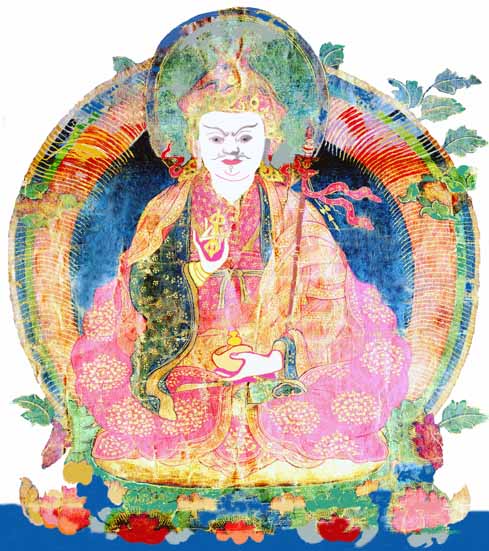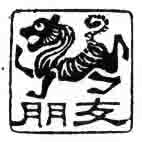Padmasambhava is a historical figure and one of the most important personalities in Tibetan Buddhism. He is the one who established Buddhism in Tibet. He is considered the Buddha of our time.

Padmasambhava is a historical figure and one of the most important personalities in Tibetan Buddhism. He is the one who established Buddhism in Tibet. He is considered the Buddha of our time.
Padmasambhava brought secret teachings to Tibet. He taught the highest form of meditation, which gives a foretaste of enlightenment.These teachings have been taught and passed down in an unbroken lineage to the present day. Padmasambhava is the creator of Vajrayana, the highest form of Buddhism, that includes all other forms.
He came to Tibet in the 8th century from Oddiyana, which is in present-day Afghanistan.
He is one of the special helpers. He has vowed to come and help whenever he is called.
A picture of Guru Rinpoche is a tremendous support for meditation for two reasons. So many details occupy the mind and give so little room for distractions. And secondly, one can become completely absorbed in this person and imagine that he is present right here and that I am receiving his meditation power and blessings.
They say meditation happens just by looking at his face. The secret is in the eyes. It is as if Padmasambhava is blessing you – just by looking at a picture of him.
All these details have a specific meaning:
Padmasambhava is enthroned on a lotus seat in the middle of a lake. His legendary birth from a lotus flower represents the spontaneous birth of consciousness and knowledge. The lotus represents purity and non-attachment. The sun shines as a sign that the darkness of ignorance has been dispelled.
He sits in a royal posture and his body radiates rainbow light that floods the entire world.
For Tibetans Padmasambhava looked exotic. He had light skin. His face was white with a touch of red. And he had a beard.
He smiles because he is friendly to us and helps us in any danger. The forehead, however, shows anger lines. As with all great masters, you can’t play with him. He will defeat all enemies.
His hat is full of associations. Guru Rinpoche is depicted wearing a hat given to him by the king of Zahor after Padmasambhava resisted all the king’s attempts to destroy him. It is a sign of supreme dignity like a crown. It is said that this lotus hat leads to enlightenment just by looking at it.
The hat has three corners symbolizing the three planes of existence (kayas: everything is empty, things are dreamlike, things are without solid substance – but they do exist). The five colors of the hat represent different five: five kayas (the three kayas plus perfect enlightenment and the unchanging), five Buddha families, or body, speech, mind, qualities, and activity.
Crowning the top of the hat is a vajra symbolizing unshakable concentration. And still further up, a vulture feather adorns the hat, symbolizing realization and the culmination of practice.
Padmasambhava wears a royal chestnut red brocade cape, an orange monk’s robe, the dark blue robe of a practitioner, and in addition the secret white clothing of a bodhisattva. It shows that he is at home in any environment.
His two hands represent skillful means and wisdom. In his right hand, at the level of the heart, he holds a golden vajra, a magical instrument, in the gesture of threat and subjugation. He makes it clear to his enemies that they had better not attack him. He subdues all negativity and protects us. His left hand rests in meditation posture in his lap and he holds a skull bowl. In it is a vase of wisdom nectar, the elixir of life that purifies, heals and gives us long life.
In the crook of his left arm and leaning on his shoulder is a trident – khatvanga. It is one of his spiritual companions in another form and a sign of supreme mastery. The three prongs represent essence, nature and compassion. Three impaled heads represent the three planes of existence (kayas) and that Padmasambhava has subdued the malevolent entities of Tibet.
His Mantra
With his mantra you can call Guru Rinpoche. He has vowed to come and help whenever he is called. A picture of him and at the same time his mantra as an object of meditation has an extremely intense effect, because the mind hardly has the possibility to escape.
The wording:
Om Ah Hung Bensa Guru Peme Siddhi Hung.
Mantras cannot be translated directly; but hints are possible: Om Ah and Hum are sacred sounds. Vajra is a sacred object with special spiritual power. Guru is the teacher. Padma is the lotus flower. And Siddhis are special supernatural abilities. In Tibetan, Hum becomes Hung, Vajra becomes Benza, and Padma becomes Peme.
